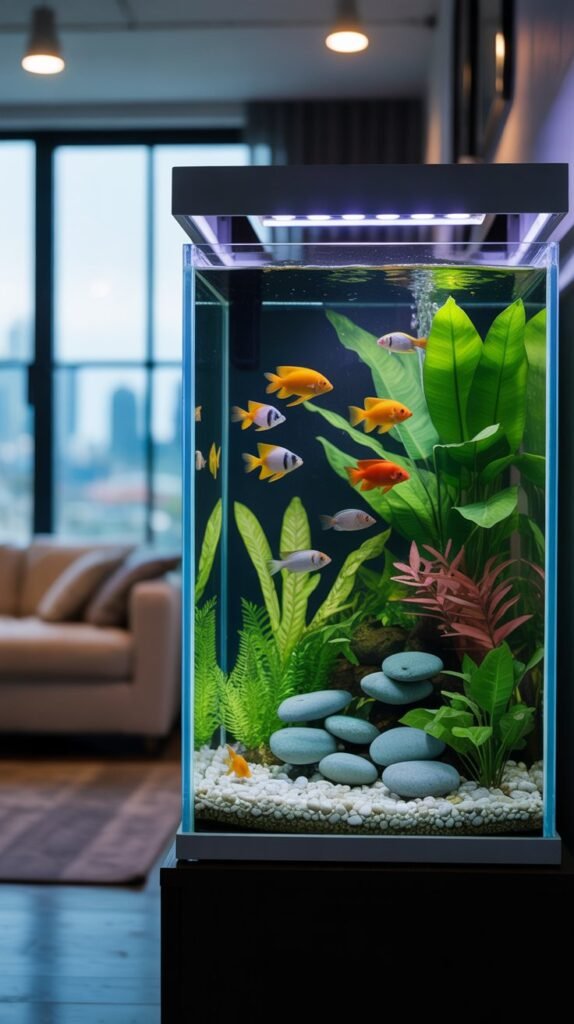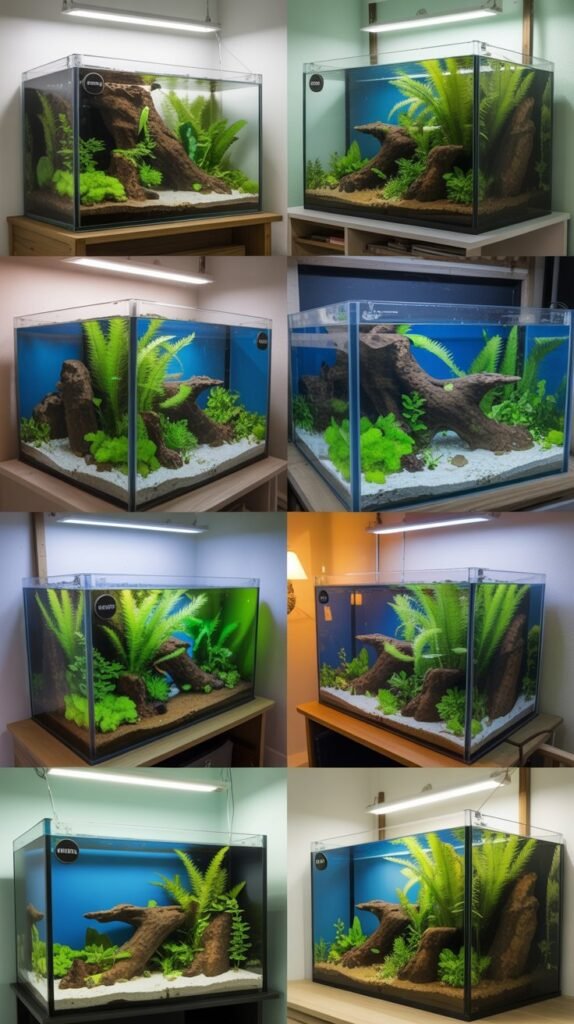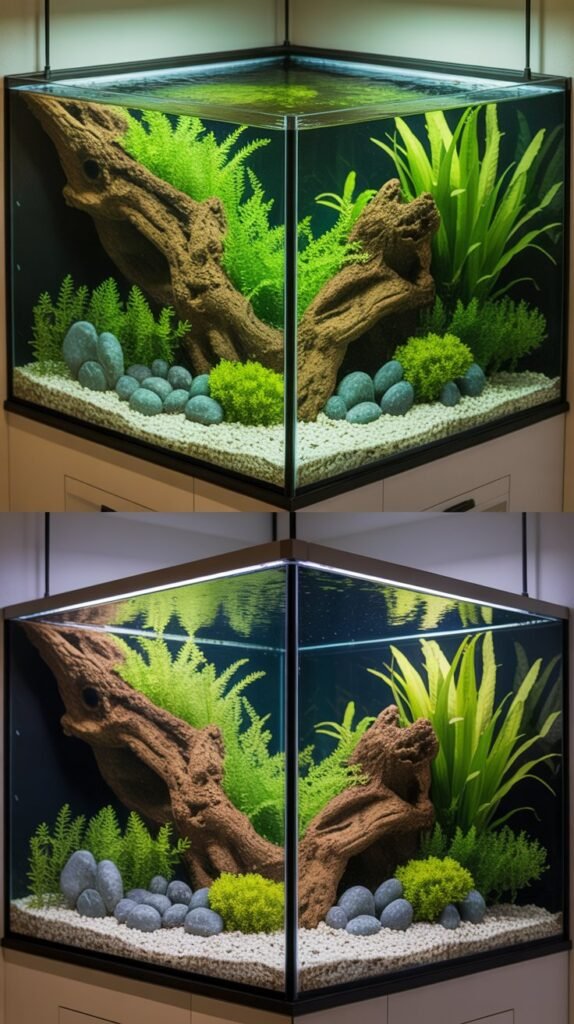Aquariums are not just homes for fish—they are living pieces of art that bring life, tranquility, and beauty into any space. While traditional rectangular aquariums are common, more aquarists are discovering the unique appeal of a corner aquarium tank. Designed to fit seamlessly into room corners, these aquariums make the most of limited space while creating a stunning focal point in your home, office, or business.
In this comprehensive guide, we’ll dive deep into everything you need to know about corner aquarium tanks—their benefits, types, setup, stocking options, and maintenance tips. Whether you’re a beginner or an experienced fish keeper, this article will help you decide if a corner aquarium is the right choice for you.
What Is a Corner Aquarium Tank?
A corner aquarium tank is a fish tank specifically designed to fit into the corner of a room. Unlike standard aquariums, which are usually rectangular, corner tanks often have unique shapes such as:
- Triangular tanks – shaped like a wedge that fits neatly into a 90-degree corner.
- Bowfront tanks – with a curved front for a panoramic viewing experience.
- Hexagonal or pentagonal tanks – offering multiple viewing angles.
These tanks maximize the use of corner spaces while adding elegance and visual depth to a room.
Why Choose a Corner Aquarium Tank?

Many aquarists are drawn to corner tanks for both practical and aesthetic reasons. Here are the key benefits:
1. Space-Saving Design
One of the biggest advantages of a corner aquarium tank is its ability to fit into spaces where a standard tank might not. If you live in an apartment, have limited wall space, or want to add an aquarium without overcrowding a room, a corner tank is the perfect solution.
2. Stunning Display
Corner aquariums are eye-catching. Their unique shapes—especially bowfront and hexagonal designs—create a panoramic effect, making the fish and decorations look more dynamic and engaging.
3. Versatility in Placement
You can place a corner aquarium in living rooms, offices, waiting areas, or bedrooms without it being intrusive. Instead of competing with other furniture, it enhances the room’s flow and aesthetic.
4. More Depth for Aquascaping
Because of their angled shape, corner tanks often provide more depth compared to flat rectangular tanks. This extra depth allows aquascapers to create beautiful layers with rocks, driftwood, and plants.
5. Ideal for Both Freshwater and Saltwater Setups
Whether you’re interested in a freshwater community tank, a planted aquascape, or a marine reef tank, a corner aquarium tank can accommodate your vision.
Types of Corner Aquarium Tanks
When choosing a corner tank, you’ll come across several designs. Let’s explore the most popular types:
1. Triangular Corner Aquarium
- Fits neatly into a 90-degree corner.
- Great for small spaces.
- Usually has a flat back and a single viewing panel.
- Best for beginners or small fish species.
2. Bowfront Corner Aquarium
- Features a curved front panel.
- Provides a wide-angle view and a sense of depth.
- Elegant and modern design, ideal for display areas.
3. Hexagonal or Pentagonal Corner Aquarium
- Offers multiple viewing angles.
- Excellent for creating 360-degree aquascapes.
- Works well in large rooms or open areas.
4. Custom-Built Corner Aquariums
- Tailored to your specific space and design needs.
- Can range from small nano tanks to large luxury aquariums.
- Often include built-in filtration systems or stands.
Choosing the Right Size Corner Aquarium Tank

The size of your corner aquarium will depend on your available space, budget, and fishkeeping goals.
- Small (10–30 gallons) – Ideal for beginners, bettas, shrimp, or nano fish.
- Medium (30–75 gallons) – Suitable for community fish, planted tanks, or small cichlids.
- Large (75+ gallons) – Perfect for reef tanks, larger freshwater species, or aquascaping enthusiasts.
Keep in mind that larger tanks are more stable in terms of water chemistry but require more space and higher upfront costs.
Equipment for a Corner Aquarium Tank
Like any aquarium, a corner tank needs the right equipment to thrive. Essential items include:
- Filtration System – A canister filter or internal filter is ideal. Some corner tanks come with built-in filtration compartments.
- Heater – For tropical fish, maintain a stable temperature.
- Lighting – Choose LED aquarium lighting, especially if keeping live plants or corals.
- Air Pump – Improves oxygen circulation.
- Stand or Cabinet – Specifically designed to support corner tanks and hide equipment.
- Aquascaping Materials – Rocks, plants, driftwood, and substrate to create a natural environment.
Best Fish for Corner Aquarium Tanks
Since corner tanks vary in size, your fish selection should match your tank’s dimensions.
For Small Corner Tanks (10–30 gallons):
- Betta fish
- Neon tetras
- Guppies
- Shrimp and snails
- Dwarf gouramis
For Medium Tanks (30–75 gallons):
- Angelfish
- Mollies, platys, and swordtails
- Corydoras catfish
- Gouramis
- Small African or South American cichlids
For Large Tanks (75+ gallons):
- Discus fish
- Large cichlids
- Saltwater reef fish
- Schooling species like silver dollars or tinfoil barbs
- Marine invertebrates like clownfish and corals
Aquascaping a Corner Aquarium

One of the most exciting aspects of owning a corner aquarium is aquascaping. Because of the unique shape, you can design creative layouts.
- Triangular tanks – Place larger rocks or driftwood at the back corner, sloping downward for depth.
- Bowfront tanks – Use the curved glass to create panoramic aquascapes with plants and schools of fish.
- Hexagonal tanks – Build a central focal point like a large rock or driftwood piece, allowing fish to swim around it.
Live plants, artificial decorations, and carefully chosen substrates can enhance the beauty of your aquarium.
Corner Aquarium Tank Maintenance Tips
Maintaining a corner aquarium is similar to any other tank, but with a few unique considerations:
- Water Changes – Perform weekly water changes (20–30%) to keep water quality high.
- Glass Cleaning – Curved glass may require special cleaning tools to avoid streaks or scratches.
- Equipment Placement – Ensure heaters, filters, and air pumps are positioned for maximum efficiency without blocking views.
- Monitor Parameters – Regularly test pH, ammonia, nitrite, and nitrate levels.
- Lighting – Adjust lighting cycles (6–8 hours for planted tanks, 8–10 for reefs) to avoid algae overgrowth.
Advantages and Disadvantages of Corner Aquarium Tanks
Like any aquarium type, corner tanks have pros and cons.
Advantages:
- Space-saving design
- Attractive focal point
- Unique aquascaping potential
- Versatile for freshwater and marine setups
Disadvantages:
- Limited stocking compared to large rectangular tanks
- Harder to find accessories like stands or lids
- Curved glass may distort views slightly
- Maintenance can be tricky in tight corners
Buying a Corner Aquarium Tank
When purchasing a corner tank, consider the following:
- Brand and Quality – Choose reputable brands like Fluval, Marineland, or custom builders.
- Stand Compatibility – Ensure you have a sturdy stand made for your tank’s shape and weight.
- Glass Thickness – For larger tanks, thicker glass or acrylic ensures durability.
- Budget – Corner aquariums may cost more than standard tanks due to their unique designs.
Conclusion
A corner aquarium tank is more than just a fish tank—it’s a statement piece. It maximizes space, enhances room aesthetics, and provides endless opportunities for creative aquascaping. Whether you want a small nano setup or a large reef system, a corner tank can fit your needs perfectly.
With the right planning, equipment, and maintenance, your corner aquarium will thrive and become a captivating centerpiece in your home or office.
FAQs About Corner Aquarium Tanks
1. Are corner aquarium tanks harder to maintain?
Not necessarily. They require the same maintenance as regular tanks, though cleaning curved glass and reaching tight corners can be slightly more challenging.
2. Do corner aquariums cost more than regular aquariums?
Yes, corner tanks are often more expensive due to their unique design and custom stands.
3. What size is best for beginners?
A 20–30 gallon corner tank is ideal for beginners—large enough to provide stability but small enough to manage.
4. Can I keep saltwater fish in a corner aquarium?
Absolutely. Corner tanks can be used for both freshwater and saltwater setups. Just ensure you have the right filtration and equipment.
5. Do fish behave differently in a corner aquarium?
No, fish behavior is generally the same. However, the unique shape may give them more hiding spaces and swimming depth.
6. Are stands for corner tanks universal?
No, you’ll need a stand specifically designed for your tank’s shape and weight.
7. Do corner tanks distort the view?
Some curved glass or bowfront models may slightly distort viewing angles, but most aquarists find it enhances the panoramic effect.

